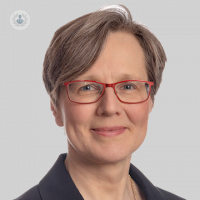Children's eyesight problems related to screen time: what parents should know
Written in association with:We recently spoke to esteemed London-based paediatric ophthalmologist, Dr Annegret Dahlmann-Noor, to find out how screen time can detrimentally affect children’s eyes, and how common short-sightedness is in children.

What eyesight-related problems in children can arise from focusing on a screen?
Whilst there is, at the moment, no robust evidence to suggest that screen time causes serious harm to children’s eyes or vision, three types of problems seem to be associated with increased screen use: dry eye problems, eye strain, and short-sightedness.
What is computer vision syndrome?
Dry-eye problems and eye strain caused by excessive screen use in adults are typically referred to as “computer vision syndrome”. When reading or looking at a screen, we blink less frequently than usual. This causes the tear film to dry up, which causes discomfort and a gritty sensation. We then blink more to spread the tear film over the surface of the eye.
In addition, in many people, including children, the meibomian glands in the eyelids do not work properly. Their role is to produce an oily layer that covers and protects the tear film. If they do not produce the right amounts of secretions, or if the secretions are too thick and do not spread out on the tear film, the dry-eye problems feel worse.
What exactly is digital eye strain, and what symptoms does it typically cause?
Focusing on small print or small images for a long time also causes eye strain, and when this happens after working on computers or other electronic devices, it is called digital eye strain. It is the result of using the focusing muscle inside the eye for extended periods of time. In addition to causing a dull ache, eye strain can also cause blurred vision.
How common is short-sightedness in children?
Short-sightedness (myopia) is becoming increasingly common in children and young people, with roughly 10 per cent of 12-year-olds and 25 per cent of 16-year-olds in the UK requiring glasses to see clearly in the distance. Whilst myopia is more common in children and young people who spend a lot of time on their devices, it is not clear whether the devices cause myopia.
We do know, however, that spending at least between one to two hours a day outdoors, in natural daylight, can significantly delay the onset of short-sightedness in young children, and also has a small beneficial effect in children who have myopia.
Should my child be spending time on his or her device before bedtime?
Beyond eyes and vision, there is evidence that demonstrates that excessive screen use, particularly before bedtime, can have adverse effects on children’s health. Children and young people go to sleep later, and so their overall sleep time is shortened. As a result, they can develop behavioural problems, such as anxiety and depression, and can also become short-tempered and restless.
Children and young people often find it hard to switch off, and can seem to become somewhat dependent on devices and social media interaction. There are physical consequences, too: if children and young people spend most of their free time on devices and do not engage with sports or other physical activities, they have a higher risk of putting on weight and developing problems such as high blood pressure and diabetes later in life.
How are dry eye and frequent blinking in children most effectively treated?
For dry eye problems and frequent blinking, warm lid compresses and lid margin cleaning can help. If the eyes become red, speak to your pharmacist or doctor, as over-the-counter artificial tear drops can bring some relief.
Dr Annegret Dahlmann-Noor is a highly proficient expert in eye conditions that affect children. If you are worried about your child’s eyesight and are wondering how much time they should be looking at a screen each day, make sure you consult with Dr Dahlmann-Noor today by visiting her Top Doctors profile.


